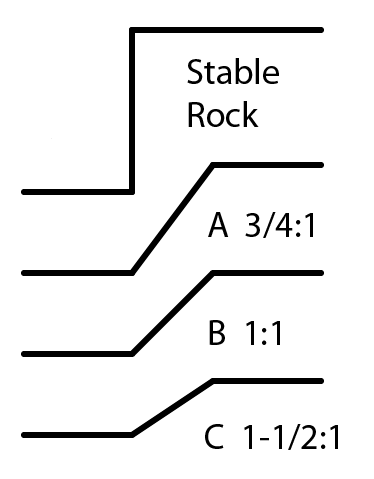Blog Archives
Trench Excavation Slope
 Banks and excavations greater than 4 feet MUST be sloped or otherwise retained. If you have the room to slope the amount of slope must not exceed the maximum allowed.
Banks and excavations greater than 4 feet MUST be sloped or otherwise retained. If you have the room to slope the amount of slope must not exceed the maximum allowed.
To determine the maximum allowable slope for an excavation you need to know the soil type in the area. Remember that ALL of these sloped excavations have a maximum depth of 20 FEET, any deeper than that and you must use some form of shoring or layering.
| Soil Type | Max Allowable Slope (H:V) |
| Rock | Veritcal |
| Type A | 3/4 : 1 |
| Type B | 1 : 1 |
| Type C | 1 1/2 : 1 |
accordng to OSHA the slope can never exceed 1 : 2.
Rock
Solid mineral material that remains upright, stable, and intact when it is excavated.
Type A (compressive strength $$1.5 \dfrac{tons}{ft^2}$$ or greater)
These are cohesive soils that contain a good amount of clay. A soil cannot be Type A if:
1. it has cracks
2. there is vibration from traffic or some other source nearby (factory)
3. It has been disturbed recently (geologically recently, like a hundred years)
4. soil is part of a sloped + layered system Click here to continue reading
Concrete Mix Design
 Concrete is made from different proportions of cement, fine aggregate (sand), coarse aggregate, and water. Cement usually comes in 94 lb sacks, water is measured by gallons (volume), and coarse and fine aggregate by weight. These are all over the place.
Concrete is made from different proportions of cement, fine aggregate (sand), coarse aggregate, and water. Cement usually comes in 94 lb sacks, water is measured by gallons (volume), and coarse and fine aggregate by weight. These are all over the place.
There are two main methods of measuring concrete ingredients, the Absolute Volume Method, and a method using Proportion ratio of components
Absolute Volume
With Absolue Volume the components are measured out using their densities or specific gravities to calculate the volume that each ingredient will use in a given unit of concrete.
$$V_a = \frac{W}{G_s \gamma_{water}}$$ Click here to continue reading
Material You Can Bring in to the Exam
 As we are nearing an exam weekend I thought it would be good to go over what you can and cannot bring in to the exam. The NCEES is extremely strict about what you have so please, unless you want to be escorted out by the police, follow their guidelines!
As we are nearing an exam weekend I thought it would be good to go over what you can and cannot bring in to the exam. The NCEES is extremely strict about what you have so please, unless you want to be escorted out by the police, follow their guidelines!
NO CELLPHONE, leave it in the car! If your Android IceCream buzzes during the test -> instant police escort.
Average End-Area Method
The Average End-Area method is a useful tool for estimating quantities in construction. It is an approximate method of calculating volume and is accurate enough for most situations.
The general concept is that you calculate the total volume (V) of a material given, the area of two ends (A) and the perpendicular distance between the two area-faces (L). For a volume comprised of several sections you sum them up:
$$ V = \sum{L \frac{A_1+A_2}{2}} $$

